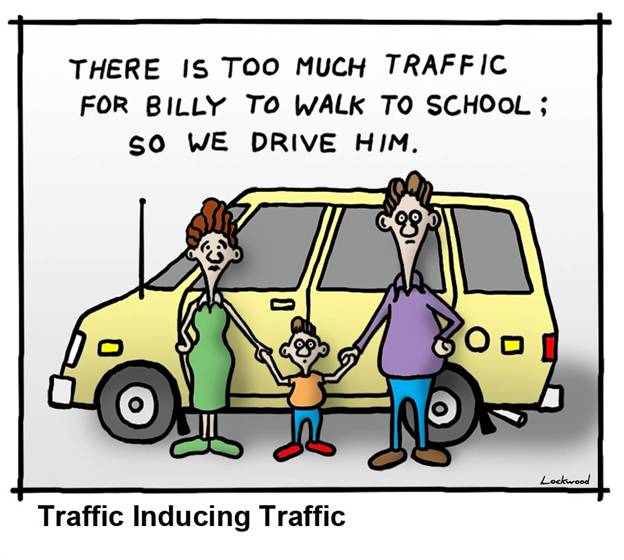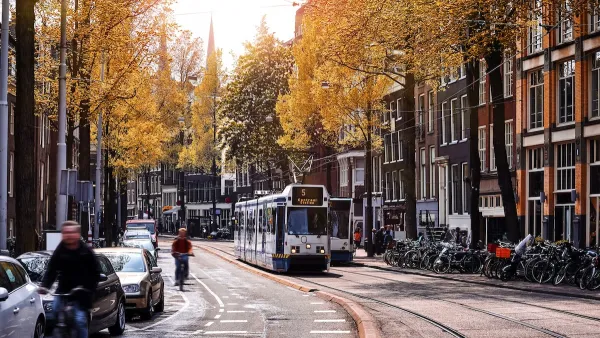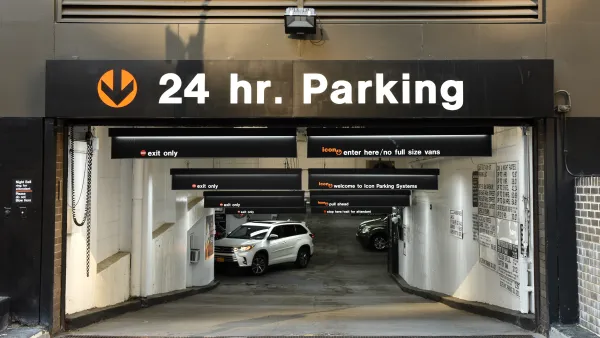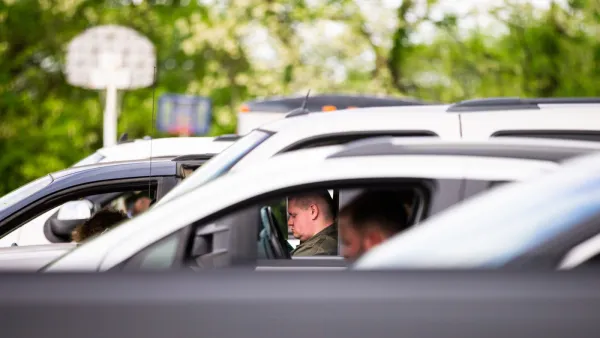Planners strive to anticipate future needs, which sometimes creates self-fulfilling prophecies: by preparing for a situation we help cause it. This is particularly true of automobile dependency. Planning decisions intended to accommodate automobile.
Planners strive to anticipate future needs, which sometimes creates self-fulfilling prophecies: by preparing for a situation we help cause it. This is particularly true of automobile dependency. Planning decisions intended to accommodate automobile travel can create a cycle of increased vehicle travel, more automobile-oriented planning, and reduced alternatives. This concept is conveyed brilliantly in the cartoon below, drawn by transportation engineer Ian Lockwood and published in the March 2012 ITE Journal.

The alternative to automobile dependency is not necessary a total lack of private vehicles (i.e., carfree communities), rather, it is a multi-modal transport system, which allows people to choose the best option for each trip: walking and cycling to reach local destinations, public transport for travel on major corridors, and automobile travel when it is truly best overall.
Decision-makers generally don't try to create automobile dependency, but many current planning practices unintentionally stimulate it. Wider roads, higher vehicle traffic speeds, increased parking requirements, and destinations located along major highways don't just facilitate automobile access, by degrading walking and cycling conditions (an impact called the barrier effect) and increasing distances between destinations they reduce access by other modes.
Automobile dependency imposes large costs on users and society. It forces people to drive even for local errands, such as transporting children to school. It makes public transit inefficient and inconvenient. It increases the costs of vehicles, parking facilities and roads borne by households, businesses and governments, as well as traffic congestion, accidents and pollution problems. It is inequitable and inefficient: it makes non-drivers significantly worse off and forces motorists to chauffeur non-driving family members and friends.
A good way to begin reducing automobile dependency is by implementing school transport management programs, which help make walking and cycling safer and more convenient. This is good in many ways: children who can walk or bike to school are healthier, happier and learn better than those who do not, and helps break the cycle of parents feeling obliged to drive because of the perceived risks of non-motorized travel.
Another good practice is for anybody involved in transport system planning to spend at least a couple weeks each year without driving, so they can experience the transport system they are creating from non-drivers' perspective. They will probably find that walking, cycling and public transit travel are sometimes enjoyable, but often frustrating due to incomplete networks, inadequate services, and poor connections – some of which can be corrected inexpensively.
The challenge for planners is to avoid traps, such as self-fulfilling prophesies and unintended consequences, which fails to create the future that we really want.
For More Information
Jeffrey R. Brown, Eric A. Morris and Brian D. Taylor (2009), "Paved With Good Intentions: Fiscal Politics, Freeways, and the 20th Century American City," Access 35 (www.uctc.net), Fall 2009, pp. 30-37; at www.uctc.net/access/35/access35.shtml.
Complete Streets (www.completestreets.org) is a campaign to promote roadway designs that effectively accommodate multiple modes and support local planning objectives.
Santhosh Kodukula (2011), Raising Automobile Dependency: How to Break the Trend?, GIZ Sustainable Urban Transport Project (www.sutp.org); at www.sutp.org/dn.php?file=TD-RAD-EN.pdf.
Todd Litman (2011), The First Casualty of a Non-Existent War: Evaluating Claims of Unjustified Restrictions on Automobile Use, and a Critique of 'Washingtons War On Cars And The Suburbs', Victoria Transport Policy Institute (www.vtpi.org); at www.vtpi.org/carwars.pdf.
Peter Newman and Jeffrey Kenworthy (1999), Sustainability and Cities; Overcoming Automobile Dependency, Island Press (www.islandpress.org).
Peter Samuel and Todd Litman (2001), "Optimal Level of Automobile Dependency; A TQ Point/Counterpoint Exchange with Peter Samuel and Todd Litman," Transportation Quarterly, Vol. 55, No. 1, Winter 2000, pp. 5-32; at www.vtpi.org/OLOD_TQ_2001.pdf.
SDC (2011), Fairness in a Car Dependent Society, U.K. Sustainable Development Commission (www.sd-commission.org.uk); at www.sd-commission.org.uk/pages/fairness-in-a-car-dependent-society.html.
Scott Sharpe and Paul Tranter (2010), "The Hope For Oil Crisis: Children, Oil Vulnerability And (In)Dependent Mobility," Australian Planner, Vol. 47, No. 4, December, pp. 284-292; summary at http://dx.doi.org/10.1080/07293682.2010.526622.
Dennis Soron (2009), "Driven To Drive: Cars And The Problem Of 'Compulsory Consumption'," Car Troubles: Critical Studies of Automobility and Auto-Mobility (Jim Conley and Arlene Tigar McLaren eds), Ashgate (www.ashgate.com), pp. 181-196; www.ashgate.com/isbn/9780754677727.
Ming Zhang (2006), "Travel Choice with No Alternative: Can Land Use Reduce Automobile Dependence?" Journal of Planning Education and Research, Vol. 25, No. 3, pp. 311-326; http://jpe.sagepub.com/cgi/content/abstract/25/3/311.
Thanks to Ian Lockwood for sharing his cartoon.

National Parks Layoffs Will Cause Communities to Lose Billions
Thousands of essential park workers were laid off this week, just before the busy spring break season.

Retro-silient?: America’s First “Eco-burb,” The Woodlands Turns 50
A master-planned community north of Houston offers lessons on green infrastructure and resilient design, but falls short of its founder’s lofty affordability and walkability goals.

Delivering for America Plan Will Downgrade Mail Service in at Least 49.5 Percent of Zip Codes
Republican and Democrat lawmakers criticize the plan for its disproportionate negative impact on rural communities.

Test News Post 1
This is a summary

Test News Headline 46
Test for the image on the front page.

Balancing Bombs and Butterflies: How the National Guard Protects a Rare Species
The National Guard at Fort Indiantown Gap uses GIS technology and land management strategies to balance military training with conservation efforts, ensuring the survival of the rare eastern regal fritillary butterfly.
Urban Design for Planners 1: Software Tools
This six-course series explores essential urban design concepts using open source software and equips planners with the tools they need to participate fully in the urban design process.
Planning for Universal Design
Learn the tools for implementing Universal Design in planning regulations.
EMC Planning Group, Inc.
Planetizen
Planetizen
Mpact (formerly Rail~Volution)
Great Falls Development Authority, Inc.
HUDs Office of Policy Development and Research
NYU Wagner Graduate School of Public Service






























